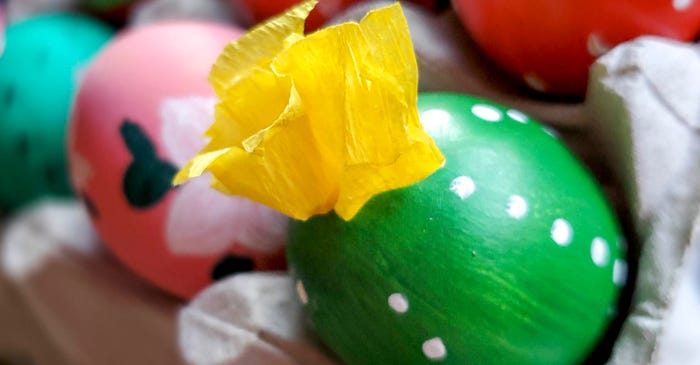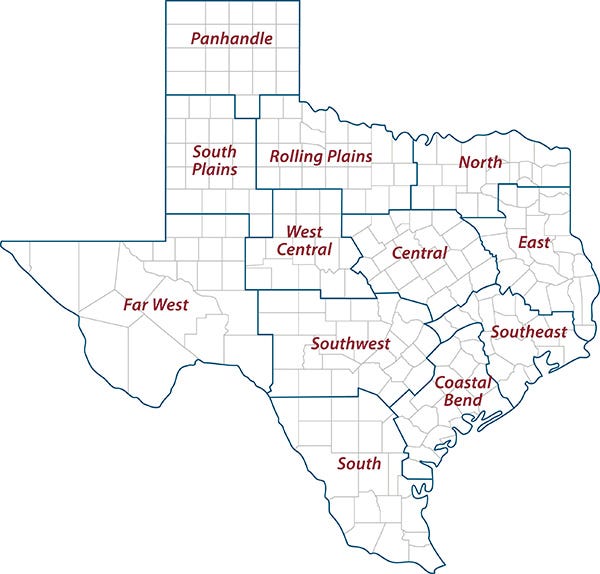
Egg prices have started their normal spring increase that peaks around Easter, according to a Texas A&M AgriLife Extension Service expert.
Craig Coufal, AgriLife Extension poultry specialist, Bryan-College Station, said the annual price spike is related to higher-than-normal demand as people prepare traditional recipes and dye eggs for Easter egg hunts.
“Prices are going up a little, but it’s just that part of the season,” he said.
The March report by Egg Industry Center at the University of Iowa showed retail prices for January 2021 were relatively the same as a year ago, around $1.46 per dozen. During 2020, prices went down during February before rising to $1.52 per dozen in March and peaking at $2.02 in April.
Coufal expects a similar trend and for prices to fall some after the holiday.

Egg producers are experiencing a different story than consumers due to rising feed costs, he said.
Prices for soybeans and corn have risen dramatically over recent months, which increased the cost of egg production. The cost to produce a dozen eggs typically averages around 60 cents per dozen but feed costs have driven that amount past 70 cents per dozen.
Coufal said the cost of egg production briefly surpassed the estimated farm value in December, which is the cash price farmers are paid. For a short time, farmers were losing 13 cents per dozen.
“That happens sometimes in egg production, but they have to get the eggs to market because they have a shelf life,” he said. “Producers should make up for those losses as egg prices rise heading into Easter, but when you start adding up 13 cents times thousands of dozens, it can be tough.”
Egg production back to normal
Consumers should expect to see a steady supply of eggs this spring. Recent appearances of egg shortages were related to temporary supply and demand imbalances, Coufal said.
Egg-laying hen populations are normal and that any recent egg shortages were driven by logistical disruptions or panic buying, he said. Temporary shortages such as panic buying in March 2020 amid COVID-19 uncertainty and recent delays of moving eggs from farms to grocery stores during Winter Storm Uri were only temporary.
“There have been no disease outbreaks, no hatching problems and no shortage of hens,” Coufal said. “Chickens only lay one egg per day, and so if normalcy is disrupted and demand doubles overnight it can appear that there’s an issue.”
The influx of backyard birds purchased for at-home egg production won’t factor into supply and demand this year either, Coufal said. The number of backyard producers impacts a miniscule piece of the egg market. Also, at-home producers typically buy heritage breeds that produce a lower volume of eggs compared to commercial breeds.
“There are roughly 320 million commercial laying hens in the U.S., and it would take millions of backyard chickens to impact the egg market,” he said. “They just don’t have the production rate, and they really can’t compete on price, so they’re still a niche market.”
Dying eggs
Coufal offered a tip for people looking to dye eggs for traditional Easter egg hunts – buy smaller eggs.
“Smaller eggs are from younger chickens,” he said. “Dye absorbs to the natural cuticle of an egg, and younger chickens put a better cuticle on the outside of their eggs.”

AgriLife Extension district reporters compiled the following summaries:

CENTRAL
Soil moisture conditions were deteriorating somewhat following another generally dry and very windy week. Only trace rainfall amounts were received. Warmer temperatures were in the forecast. Winter wheat was developing well; some fields reached the flag leaf stage. Preemergent herbicide applications continued for wheat. Early planted wheat fields were expected to start heading soon. Oat fields were recovering somewhat from the freeze, but stand losses were evident. Corn planting was mostly complete, and planted acres were up. Nights were cool, keeping growers from getting into sorghum planting. Sorghum seed sales were up, and expectations were for more planted acres than last year. There was some urgency among producers to have all sorghum plantings completed before month’s end to avoid insect pest problems later during the year. Cotton acres may decline despite prices being up. Pastures were greening up, and winter forages put on more growth. Livestock were in excellent shape.
ROLLING PLAINS
Some areas received light rain. Soil moisture levels were drying each day, moisture was needed. Winter wheat looked better after a rain, but growth stages were still behind schedule. Some stocker cattle were moved off wheat pastures.
COASTAL BEND
Weather was mild with light showers to some areas, and soil moisture was declining. Precipitation was needed. Most corn and grain sorghum fields were planted and emerged with good looking stands. Some cotton was emerging, and plantings continued. Some cotton was dry planted. Rice planting continued. Weeds were sprayed by some producers. Fertilizer was applied on hay fields. Rangeland and pasture conditions were improving with sunshine and warmer days, but rain was needed to keep conditions improving. Supplemental feeding for cattle continued. Livestock were in good condition with market prices steady. Spring vegetable gardens were being planted. Many local homeowners were calling about recommendations to save their citrus trees after the winter storm. Oak trees were shedding leaves and blooming. Huisache trees were still in shock from the hard freeze.
EAST
Warmer temperatures and recent rainfall helped green up pastures. Many producers were able to reduce feeding hay or stop altogether. Vegetable crops looked good. Marion County reported homeowners were beginning to plant gardens. Pasture and rangeland conditions were fair to good. Subsoil and topsoil conditions were adequate. Livestock were in fair to good condition. Buffalo gnat and horn fly numbers increased. Feral hogs continued to be a problem in most areas. Sabine County reported feral hog sightings and signs reduced significantly.
SOUTH PLAINS
Some rain was received, but subsoil and topsoil moisture levels remained poor to fair from lack of moisture and high winds. Producers continued to irrigate and prepare fields for planting. Cattle were in good condition.
PANHANDLE
Topsoil moisture levels were short to adequate, and subsoil levels were adequate to very short. Pasture and rangeland conditions were very poor to fair. Winter wheat was in poor to good condition, and oats were fair. Snowfall was received and was beneficial to small grains, cover crops and pastures. Cattle were still receiving supplemental feed on rangeland but green-up was approaching.
NORTH
Topsoil moisture ranged from short to adequate. Temperatures were cooler. Counties reported trace amount to half an inch of rain. Ryegrass pastures sprang to life. Bermuda and Bahia grasses started to emerge from dormancy. Winter wheat looked excellent. Corn planting started. Producers in some areas were unable to plant due to wetter soil moisture conditions. Livestock were in good condition. Spring-born calves were doing well. Hay supplementation continued but was slowing down due to forage growth. Pasture conditions were greening up.
FAR WEST
Temperature variances were extreme with nights and mornings low in the mid-30s to low 40s and daytime highs ranging from the high 50s to mid-80s. Conditions were extremely dry, with no true precipitation reported. High winds depleted topsoil moisture considerably. Producers worked continuously to plow to keep fields from blowing. Wind gusts as high as 50 mph created dust storms with low visibility for long periods of time. Several roads were closed due to low visibility. Telephone poles, barns and sheds were blown down by high winds. Winter wheat, oat, pasture and rangeland conditions continued to worsen. Beef cattle were still in overall good condition. Irrigated wheat made progress and a few fields reached the joint stage. Dryland wheat was still a long way away from jointing and may not have enough time to make a crop. Some fields were terminated to save moisture for an upcoming cotton crop. Many cotton producers without cover crops were sand fighting. Some producers turned on drip irrigation for cotton planting. A few corn fields were planted. Fields were being prepared for sorghum and watermelons. Pastures remained very dry with almost nothing to graze, and producers continued to supplement feed for livestock and wildlife. Lambing and kidding continued.
WEST CENTRAL
Weather conditions were relatively warm and dry following scattered rain showers early in the week. Rangeland and pasture conditions improved as spring green-up began. Winter wheat was in mostly fair to good condition and showing improvement. Fieldwork, including preparation for hay and sorghum crops, was underway. Cattle markets were steady on stocker and feeder heifers and steers. Supplemental feedings for livestock were decreasing slowly.
SOUTHEAST
Rice planting started. Rain amounts were up to a quarter inch, and fields continued to dry out. Some farmers with prepared fields were planting, but some farmers were behind schedule due to wet field conditions. Pastures were greening up, and most producers began to put out nitrogen. Pastures should begin to take off nicely following forecasted rains. Rangeland and pasture ratings were fair to very poor, with fair ratings being the most common. Soil moisture levels ranged from adequate to very short with adequate levels being the most common.
SOUTHWEST
Moisture conditions were declining, and no rainfall was reported. Rangeland and pasture conditions declined as well. Gillespie County reported corn and milo plantings were in full swing. Guadalupe County reported corn planting was near completion. Caldwell County reported cattle markets were lower while sheep and goat markets were high. Spring lambing, kidding and calving continued. Livestock and wildlife conditions were fair to good, and supplemental feeding continued.
SOUTH
Conditions were mostly dry and windy. Soil moisture conditions were short to very short in most areas, and adequate in a few locations, but all areas needed rainfall. Light rainfall was reported in a few areas. Corn and sorghum plantings were underway and almost complete in some areas. Some corn and sorghum replanting continued. Forage grasses needed rain. Strawberry harvest was slowly coming on after the freeze put it behind four to five weeks. Wheat and oats fields were heading. Pastures and rangelands were starting to green up. Some pastures were in very poor condition and posed fire danger. Daily grass fires were reported in some areas. All crops were being irrigated due to the lack of rainfall, and supplemental feeding of livestock continued. Mesquite trees and native black brush were blooming. Landscaping that was trimmed back started to show new growth. Food plots of oats were seeding out and ready for bailing. Producers planned fields for sunflowers and sorghum. Farmers continued to plant grain crops, but most cotton plantings were temporarily on hold due to dry soil conditions. Some producers were planting cotton and sesame. Most planted fields were emerging well, but some additional moisture will be necessary to make a crop. Beef cattle conditions were declining where grazing and hay was limited. Producers continued to cull herds. Auction barns reported some herd sell offs due to drought. Ranchers were also providing water for cattle and wildlife. Hay prices were from $65-$80 per round bale. Farmers were planting vegetables and continued to use canal water to irrigate crop fields. Coastal Bermuda grass was already green and looked good for hay production soon. Sugarcane harvest continued, and citrus trees were being irrigated and fertilized. Some citrus trees were greening up, but a significant percentage remained brown and likely dead. Watermelons and summer fruits and vegetables were green and growing under irrigation.
Read more about:
EggsAbout the Author(s)
You May Also Like




